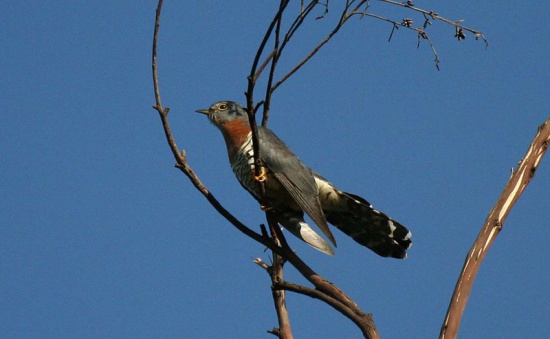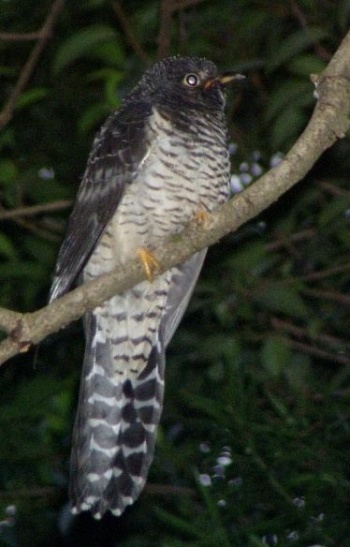(→Taxonomy: Update link) |
|||
| (One intermediate revision by the same user not shown) | |||
| Line 1: | Line 1: | ||
| + | [[Image:23133red-chested_cuckoo_DB.jpg|thumb|550px|right|Photo by {{user|megan+perkins|megan perkins}}<br />Outspan hotel, [[Kenya]], December 2006]] | ||
;[[:Category:Cuculus|Cuculus]] solitarius | ;[[:Category:Cuculus|Cuculus]] solitarius | ||
| − | |||
| − | |||
| − | |||
==Identification== | ==Identification== | ||
| − | Length 28-30 cm; mass 67-90 g; males generally larger than females. | + | Length 28-30 cm; mass 67-90 g; males generally larger than females.<br /> |
| − | + | '''Adult''': Dark grey head and back, rufous chest. The eye is brown, the bill black, and the legs yellow. Rufous breast with grey chin and throat diagnostic. Back darker than [[Common Cuckoo]] and [[African Cuckoo]] and paler than western form of [[Black Cuckoo]].<br /> | |
| − | '''Adult''': Dark grey head and back, rufous chest. The eye is brown, the bill black, and the legs yellow. Rufous breast with grey chin and throat diagnostic. Back darker than [[Common Cuckoo]] and [[African Cuckoo]] and paler than western form of [[Black Cuckoo]]. | ||
| − | |||
'''Juvenile''': Lacks the rufous breast of the adult; upper parts, throat and breast almost black. | '''Juvenile''': Lacks the rufous breast of the adult; upper parts, throat and breast almost black. | ||
| − | + | [[Image:2007_0124_JuvRedchestedCuckoo_AlanManson.jpg|thumb|350px|right|Juvenile <br />Photo by {{user|Alan+Manson|Alan Manson}}<br />Pietermaritzburg, [[South Africa]], January 2007]] | |
| − | |||
==Distribution== | ==Distribution== | ||
| − | Much of sub-Saharan [[Africa]]; absent from the most arid areas. | + | Much of sub-Saharan [[Africa]]; absent from the most arid areas.<br /> |
| + | '''Western Africa''': [[Senegambia]], [[Senegal]], [[Guinea-Bissau]], [[Guinea]], [[Sierra Leone]], [[Liberia]], [[Ivory Coast]], [[Burkina Faso]], [[Ghana]], [[Togo]], [[Benin]], [[Nigeria]], [[Chad]], [[Cameroon]], [[Central African Republic]], [[Equatorial Guinea]], [[Gabon]], [[DRC]] and [[Angola]]<br /> | ||
| + | '''Eastern Africa''': [[Sudan]], [[Ethiopia]], [[Kenya]], [[Uganda]], [[Rwanda]], [[Burundi]], [[Tanzania]], [[Zambia]], [[Mozambique]] and [[Malawi]]<br /> | ||
| + | '''Southern Africa''': [[Botswana]], [[Zimbabwe]], [[South Africa]], [[KwaZulu-Natal]], [[Lesotho]] and [[Swaziland]]<br /> | ||
| + | '''African Islands''': Gulf of Guinea Islands, [[Bioko]] (Fernando Po) | ||
==Taxonomy== | ==Taxonomy== | ||
| − | Most authorities view this as a monotypic species, however, some recognize a second subspecies ''magnirostris''. | + | Most authorities view this as a [[Dictionary_M-O#M|monotypic]] species<sup>[[#References|[1]]]</sup>, however, some recognize a second subspecies ''magnirostris''<sup>[[#References|[2]]]</sup>. |
| + | |||
==Habitat== | ==Habitat== | ||
Forest, closed woodland, plantations, clumps of trees, wooded gardens and parks. | Forest, closed woodland, plantations, clumps of trees, wooded gardens and parks. | ||
==Behaviour== | ==Behaviour== | ||
| − | Intra-African migrant. Usually solitary; calls frequently in breeding season, but otherwise inconspicuous. Diet | + | Intra-African migrant. Usually solitary; calls frequently in breeding season, but otherwise inconspicuous. |
| − | + | ====Diet==== | |
| − | + | Invertebrates (mainly hairy caterpillars), small frogs and lizards, fruit and eggs. Feeds mainly in canopy. | |
| − | + | ====Breeding==== | |
| + | A brood parasite; the hosts are mainly Robin-Chats and Thrushes, the most common hosts in southern Africa being [[Cape Robin Chat]], [[Cape Wagtail]], and [[White-throated Robin Chat]]. Its eggs are brown and it can lay 20 eggs in a season in different nests. | ||
| + | ====Vocalisation==== | ||
| + | The characteristic three-note ''piet-my-vrou'' call of the male is diagnostic; the females call ''pipipipipi''. | ||
==References== | ==References== | ||
| − | + | #{{Ref-Clements6thDec09}}#Avibase | |
| + | #{{Ref-Hockeyetal05}} | ||
| + | {{ref}} | ||
==External Links== | ==External Links== | ||
{{GSearch|Cuculus+solitarius}} | {{GSearch|Cuculus+solitarius}} | ||
[[Category:Birds]] [[Category:Cuculus]] | [[Category:Birds]] [[Category:Cuculus]] | ||
Revision as of 22:43, 10 July 2014
- Cuculus solitarius
Identification
Length 28-30 cm; mass 67-90 g; males generally larger than females.
Adult: Dark grey head and back, rufous chest. The eye is brown, the bill black, and the legs yellow. Rufous breast with grey chin and throat diagnostic. Back darker than Common Cuckoo and African Cuckoo and paler than western form of Black Cuckoo.
Juvenile: Lacks the rufous breast of the adult; upper parts, throat and breast almost black.
Distribution
Much of sub-Saharan Africa; absent from the most arid areas.
Western Africa: Senegambia, Senegal, Guinea-Bissau, Guinea, Sierra Leone, Liberia, Ivory Coast, Burkina Faso, Ghana, Togo, Benin, Nigeria, Chad, Cameroon, Central African Republic, Equatorial Guinea, Gabon, DRC and Angola
Eastern Africa: Sudan, Ethiopia, Kenya, Uganda, Rwanda, Burundi, Tanzania, Zambia, Mozambique and Malawi
Southern Africa: Botswana, Zimbabwe, South Africa, KwaZulu-Natal, Lesotho and Swaziland
African Islands: Gulf of Guinea Islands, Bioko (Fernando Po)
Taxonomy
Most authorities view this as a monotypic species[1], however, some recognize a second subspecies magnirostris[2].
Habitat
Forest, closed woodland, plantations, clumps of trees, wooded gardens and parks.
Behaviour
Intra-African migrant. Usually solitary; calls frequently in breeding season, but otherwise inconspicuous.
Diet
Invertebrates (mainly hairy caterpillars), small frogs and lizards, fruit and eggs. Feeds mainly in canopy.
Breeding
A brood parasite; the hosts are mainly Robin-Chats and Thrushes, the most common hosts in southern Africa being Cape Robin Chat, Cape Wagtail, and White-throated Robin Chat. Its eggs are brown and it can lay 20 eggs in a season in different nests.
Vocalisation
The characteristic three-note piet-my-vrou call of the male is diagnostic; the females call pipipipipi.
References
- Clements, JF. 2009. The Clements Checklist of Birds of the World. 6th ed., with updates to December 2009. Ithaca: Cornell Univ. Press. ISBN 978-0801445019.
- Avibase
- Hockey, PAR, WRJ Dean, and PG Ryan, eds. 2005. Roberts' Birds of Southern Africa. 7th ed. Cape Town: John Voelcker Bird Book Fund. ISBN 978-0620340533
Recommended Citation
- BirdForum Opus contributors. (2024) Red-chested Cuckoo. In: BirdForum, the forum for wild birds and birding. Retrieved 20 April 2024 from https://www.birdforum.net/opus/Red-chested_Cuckoo





